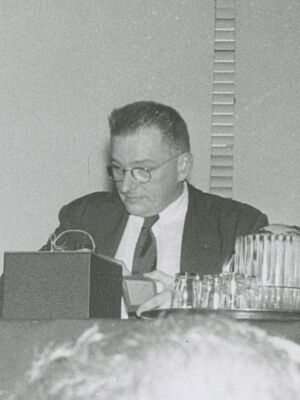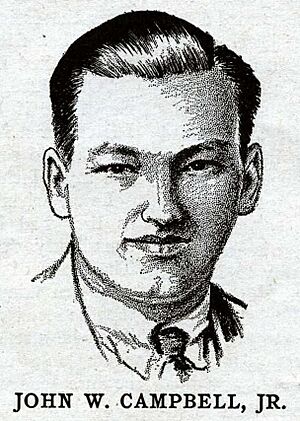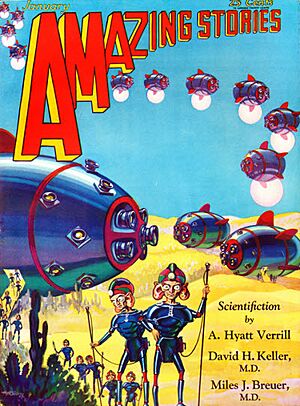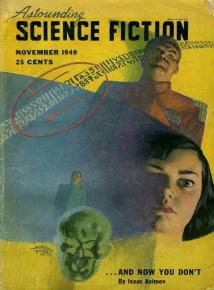John W. Campbell facts for kids
Quick facts for kids
John W. Campbell
|
|
|---|---|

Campbell in 1956
|
|
| Born | John Wood Campbell Jr. June 8, 1910 Newark, New Jersey, U.S. |
| Died | July 11, 1971 (aged 61) Mountainside, New Jersey, U.S. |
| Pen name | Don A. Stuart |
| Occupation | Magazine editor, writer |
| Nationality | American |
| Alma mater | Massachusetts Institute of Technology (no degree) Duke University (BS, physics, 1934) |
| Period | 1930–1971 |
| Genre | Science fiction |
| Signature | |
 |
|
John W. Campbell Jr. (born June 8, 1910 – died July 11, 1971) was an American science fiction writer and editor. He was the editor of Astounding Science Fiction magazine from 1937 until his death. This magazine later became Analog Science Fiction and Fact. Campbell was a very important person during the "Golden Age of Science Fiction". He wrote exciting space adventure stories under his own name. He also used the pen name Don A. Stuart for other types of stories. His famous story Who Goes There? was made into three movies called The Thing from Another World (1951), The Thing (1982), and The Thing (2011).
Campbell started writing science fiction when he was 18. He helped many famous science fiction authors get their start. These included Isaac Asimov, Robert A. Heinlein, Theodore Sturgeon, and Arthur C. Clarke. After he passed away, two awards were named in his honor. These were the John W. Campbell Memorial Award for Best Science Fiction Novel and the Astounding Award for Best New Writer. In 1996, he was added to the Science Fiction and Fantasy Hall of Fame.
Contents
John Campbell's Early Life and Education
John Campbell was born in Newark, New Jersey, in 1910. His father, John Wood Campbell Sr., was an electrical engineer. John went to Blair Academy, a boarding school, but did not finish there.
He also attended the Massachusetts Institute of Technology (MIT). He studied there but did not earn a degree. Later, he went to Duke University and graduated in 1934. He earned a Bachelor of Science degree in physics.
John Campbell's Writing Career

Campbell began writing science fiction when he was 18 years old. His first stories were published in Amazing Stories magazine. These early stories made him known for writing exciting space adventures.
In 1934, he started writing stories with a different style. For these, he used the pen name Don A. Stuart. This name came from his wife's maiden name. He wrote many successful stories under both his own name and Don A. Stuart.
One of his most famous stories as Don A. Stuart was Who Goes There?. This story is about researchers in Antarctica who find a crashed alien spaceship. The alien can change its shape. This story was published in 1938. It was later made into three popular movies called The Thing. After 1937, Campbell mostly stopped writing fiction. He focused on his work as an editor.
Campbell also had a hobby as an amateur radio operator. He wrote many articles about electronics and radio for different magazines.
John Campbell's Editing Career
In 1937, John Campbell became the editor of Astounding Stories. He quickly started making changes to the magazine. In 1938, he changed the title to Astounding Science-Fiction.
Campbell helped discover and support many new writers. In 1939, he published the first stories by authors like A. E. van Vogt, Isaac Asimov, Robert A. Heinlein, and Theodore Sturgeon. This time is often called the "Golden Age of Science Fiction" because of all the great new talent.
In 1939, Campbell also started a fantasy magazine called Unknown. This magazine was important for modern fantasy stories. However, it stopped being published after four years due to paper shortages during World War II.
Campbell continued to edit Astounding (later Analog) until he died in 1971. He was 61 years old.
John Campbell's Influence on Science Fiction
Many people believe that John Campbell had a huge impact on modern science fiction. The Encyclopedia of Science Fiction said he helped shape the genre more than anyone else. He encouraged writers to create more intelligent stories for adults.
Campbell often gave writers ideas for their stories. He would challenge them to think differently. For example, he once asked for a creature that thinks better than a human, but not like a human. He also sometimes bought cover paintings first and then asked writers to create stories to match them.
He had a strong influence on Isaac Asimov, who became a close friend. Asimov said Campbell was "the most powerful force in science fiction ever." Campbell pushed writers to understand both science and people in their stories.
One famous example of his influence is the story "Deadline" by Cleve Cartmill. This story, published in 1944, described how to build an atomic bomb. The FBI visited Campbell's office after it came out. They wanted the magazine removed from stores. Campbell convinced them that removing it would only make people more curious. So, the demand was dropped.
Campbell also hosted a weekly science fiction radio show. It was called Exploring Tomorrow and ran from 1957 to 1958.
John Campbell's Views and Controversies
John Campbell was known for having strong opinions. He enjoyed debating different ideas, even if he didn't fully agree with them.
Later in his life, some of Campbell's views became controversial. He sometimes published essays that supported ideas that were different from what many in the science fiction community believed. These views caused some disagreements with his writers and readers.
For example, Campbell believed that stories about aliens should always show humans as being better or more capable. This meant that in Astounding and Analog magazines, human characters were often shown as superior to aliens.
Campbell was also a heavy smoker. He wrote editorials that questioned the link between smoking and lung cancer. He also criticized government rules about health and safety. He believed that too much regulation could prevent good new ideas from being used.
He was also interested in pseudoscience and parapsychology, like ESP (extrasensory perception). He encouraged writers to include these topics in their stories. This led to many tales about telepathy and other "psionic" powers. He also supported some unusual inventions and theories that were not accepted by mainstream science.
In 1949, Campbell worked with L. Ron Hubbard on ideas that later became Dianetics. Campbell published some of Hubbard's early work in Astounding. However, they later disagreed and went their separate ways.
Some writers, like Isaac Asimov, felt that Campbell's focus on these ideas pushed them away. Asimov said that Campbell "championed far-out ideas" and sometimes expressed political views that many disagreed with.
How Others Saw John Campbell
Many people in the science fiction world had strong opinions about John Campbell.
Algis Budrys said that Campbell was "the greatest editor SF has seen." He believed Campbell saved and improved science fiction. Poul Anderson also said Campbell "saved and regenerated science fiction" by raising its standards.
However, some people found Campbell difficult to talk to. Isaac Asimov described him as "talkative, opinionated, quicksilver-minded, overbearing." He said talking to Campbell often felt like listening to a long speech.
Some science fiction writers also criticized Campbell for his views. Samuel R. Delany said Campbell rejected one of his novels because the main character was black. Joe Haldeman also mentioned that Campbell rejected a story because the main soldier character was female.
Despite these criticisms, many writers, including Asimov, remained grateful for Campbell's early support. Asimov dedicated a book to him, saying there was "no way at all to express how much he meant to me."
Awards and Honors for John Campbell
John Campbell and his magazine Astounding won many awards. They shared one of the first Hugo Awards in 1953. Campbell and Astounding/Analog won the Hugo Award for Best Professional Editor seven more times. They also won the Hugo Award for Best Professional Magazine eight times. His novella Who Goes There? also won a Hugo Award. In total, he won seventeen Hugo Awards.
After Campbell's death, the University of Kansas created the annual John W. Campbell Memorial Award for Best Science Fiction Novel. The World Science Fiction Society also created the John W. Campbell Award for Best New Writer. However, in 2019, this award was renamed the "Astounding Award for Best New Writer" due to discussions about Campbell's controversial views.
In 1996, John Campbell was inducted into the Science Fiction and Fantasy Hall of Fame. A crater on Mars was also named "Campbell" in his honor.
John Campbell's Books
Here are some of the books John Campbell wrote or edited:
Novels
- Beyond the End of Space (1933)
- Conquest of the Planets (1935)
- The Mightiest Machine (1947)
- The Incredible Planet (1949)
- The Black Star Passes (1953)
- Islands of Space (1956)
- Invaders from the Infinite (1961)
- The Ultimate Weapon (1966)
Short Story Collections
- Who Goes There? (1948)
- The Moon is Hell (1951)
- Cloak of Aesir (1952)
- The Planeteers (1966)
- The Best of John W. Campbell (1973)
- The Space Beyond (1976)
- A New Dawn: The Don A. Stuart Stories of John W. Campbell, Jr. (2003)
Books He Edited
- From Unknown Worlds (1948)
- The Astounding Science Fiction Anthology (1952)
- Prologue to Analog (1962)
- Analog I (1963)
- Analog II (1964)
- Analog 3 (1965)
- Analog 4 (1966)
- Analog 5 (1967)
- Analog 6 (1968)
- Analog 7 (1969)
- Analog 8 (1971)
Nonfiction Works
- Collected Editorials from Analog (1966)
- The John W. Campbell Letters, Volume 1 (1986)
- The John W. Campbell Letters with Isaac Asimov & A.E. van Vogt, Volume II (1993)
Images for kids





